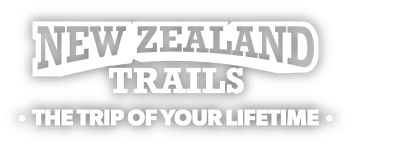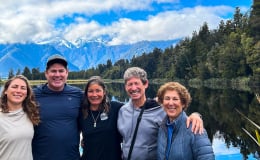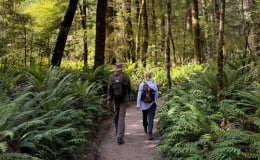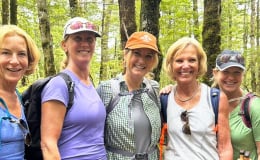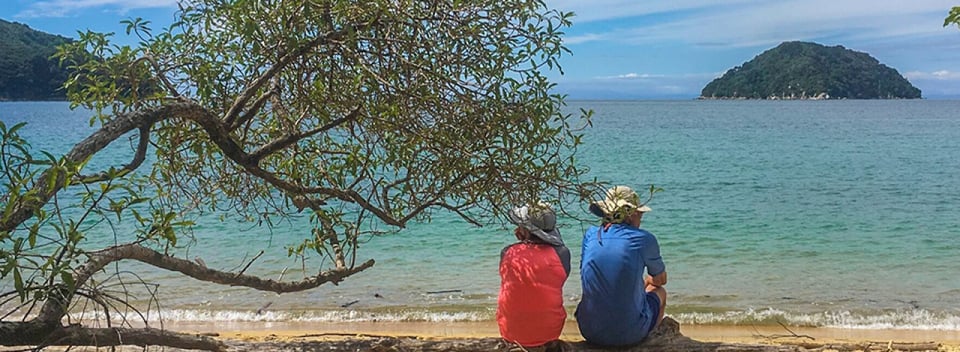
Hike and Kayak Abel Tasman National Park

Small but perfectly formed, Abel Tasman National Park is the ideal place to relax, adventure and explore. Renowned for its natural beauty and idyllic views, Abel Tasman’s golden sand beaches, crystal clear waters, hidden lagoons and secluded bays are truly lust worthy!

Pristine beaches as far as the eye can see in Abel Tasman National Park!
Visitors flock from near and far to enjoy the delights on offer, but what’s the best way to explore and how can you make the most of your Abel Tasman experience? It can be a busy part of the country, so how do you avoid the crowds?* Read on for our definitive Abel Tasman guide and exclusive tips from locals in the know.
*our definition of a crowd is more than 14 people in one place at a time!
Abel Tasman National Park – an overview
At a relatively compact 22,530 hectares (55,673 acres), Abel Tasman is the smallest of New Zealand’s 13 national parks. But despite its diminutive dimensions, there’s plenty for visitors to see and do, from kayaking the calm blue waters, to hiking the world-class Abel Tasman Coast Track.
Historically inhabited by the early Maori for some 500 years, the rich coastline and lush forests provided a hospitable home to New Zealand’s indigenous population. On 18th December 1642, the Dutch seafarer Abel Tasman anchored his ships in Golden Bay and became the first European to set foot on Aotearoa (New Zealand). Unfortunately, his visit culminated in disaster following an altercation with the local people and he soon sailed on. Some 300 years on from his unsuccessful visit, the coastline and surrounding area was designated a national park in 1942 and named after Abel Tasman.
Today Abel Tasman National Park is one of New Zealand’s best known and most treasured landscapes. It’s popular with locals and visitors alike, but fortunately there are still quiet spots and deserted beaches to be found. The coastline, forest and granite headland are home to many native birds such as the bellbird, fantail, pigeon and tui, with various wading birds and little penguins making their nests on the park’s islands as well. For those keen to see more of New Zealand’s wildlife, Abel Tasman National Park is a great place to enjoy watching these curious creatures in their natural habitat.

Abel Tasman day hikes introduce you to a plethora of native New Zealand wildlife, like this handsome oystercatcher.
With a reputation as one of the sunniest places in New Zealand, Abel Tasman’s climate is mild year-round. The most popular time to visit is during the summer months from December to February but ask a local and you’ll soon discover that there’s really no bad time of year to visit. We recommend travelling between October and April to make the most of the longer daylight hours and your time in this beautiful part of the country. Find out more here about the best time to visit New Zealand.
Getting there
Abel Tasman National Park is located at the top of the South Island of New Zealand between Golden Bay and Tasman Bay. The closest towns are Motueka (try the ice cream), Takaka (relax and enjoy the hippy vibe) and Kaiteriteri (soak up the views from the pristine beachfront). There are regular bus services to Abel Tasman from these towns, as well as nearby Nelson - a colourful city with an artisan undercurrent. You can also catch a water taxi or make your own way by car. The main road into the national park is via Marahau and it’s about a 25-minute drive from Motueka, 1 hour from Takaka or 1 hour 15mins from Nelson.
The closest international airport is Wellington at the bottom of the North Island. From there it’s a short domestic hop across to Nelson airport. Or, hire a vehicle and take the car ferry across the Cook Strait from Wellington to Picton, which is then just under a 3-hour drive to Abel Tasman National Park.
If you’re planning on hiring a car and making your own way, make sure you check the map beforehand and book your car ferry well in advance. You can drive from anywhere on the South Island, such as Queenstown or Christchurch, but be aware that it might be a long drive than you expect. We don’t have many motorways here, so you’ll be driving over rugged mountain passes and following winding coastal roads. The views are outstanding but be sure to factor in rest stops and maybe even a night’s stay somewhere along the way to break up the journey. Make sure you’re not jet-lagged before heading out and ensure there’s someone else to give directions so you can concentrate on the road ahead.
Taking the bus could be a better option for some, with direct services to Abel Tasman National Park from the closest towns and a wider network of coach links to get you to those towns. Do a little research online and buy your bus tickets in advance. Of course, the simplest choice would be to join a small group guided tour and let us take care of all the logistics for you. That way you get to focus on the views, rather than the bus timetable!

No buses to wait for around here! Take your time and soak up the views on the Abel Tasman Coast Track.
If you’re looking to walk the Abel Tasman Coast Track or any of the Abel Tasman day hikes, we’ll give you a little more information on how to get there in the Abel Tasman National Park hiking section below.
Accommodation
There are plenty of charming accommodation options in the surrounding towns of Abel Tasman, from self-catered apartments and backpacker motels to luxurious lodges and B&Bs, so there’s something to suit all budgets.
If you’re planning on staying in the national park itself, there are a variety of options depending on what you’d like to do while you’re there. Choose from lodges, cabins and cottages, or DOC huts if you’re heading out on the Abel Tasman Coast Track.
Our favourite option is to pitch a tent under the stars in a quiet cove along the coastline. The only way to reach some of these idyllic spots is by sea kayak or boat - you’ll feel a long way from home as you soak up your tranquil surroundings. You can book a tent site on the DOC website, or join us on a guided kayak adventure and we’ll take care of all the details, including finding the best spot to camp and whipping you up a lovely hot meal in the evening after an incredible day out on the water.
Things to do
Once you’ve successfully reached the oasis of Abel Tasman, there are many incredible activities to fill your time. Abel Tasman National Park hiking is probably the most popular way to explore, with various day hikes as well as overnight tramping options available. We’ll delve a little deeper into those below.
If you’re keen to kayak Abel Tasman, we’ve got you covered too. We reckon it’s one of the best ways to explore all the hidden coves the Abel Tasman Coast Track passes by. Check out the kayaking section below for more details as well as a first-hand account of Super Guide Shona’s adventure on Abel Tasman’s high seas!
Other activity options include camping, swimming, snorkelling, hunting (check out DOC’s website for specific details if that’s your thing), mountain biking and sunbathing with a good book!
Mountain Biking
Fans of mountain biking will be happy to know that there are excellent purpose-built and multi-use tracks in and around Abel Tasman. The Rameka Track is a single track with plenty of rocky and rooty sections, perfect for those up for a challenge. At 20km (12.4 miles) long, the trail winds down the Takaka Hill to Golden Bay through native forest and bush. The views are outstanding on the way down and there’s nothing like taking a dip in the sea at the end of your ride! The Gibbs Hill Track is also popular with bikers and can be accessed by those on two wheels between 1st May and 1st October each year.
The Kaiteriteri Mountain Biking Park on the edge of Abel Tasman National Park has options for all abilities, from beginner to advanced. Hire a bike from a local outlet and spend the day exploring the trails. Finish off with a crisp New Zealand craft beer teamed with fish and chips on the beach – perfect!
Abel Tasman National Park Hiking
Abel Tasman is primarily known for the Abel Tasman Coast Track, one of New Zealand’s 10 Great Walks. Stretching 60km (37.3 miles) between Wainui and Marahau, this beautiful and family-friendly hiking trail traverses golden sand beaches and lush native forests, past quiet bays, hidden waterfalls and rock pools. Taking between three and five days depending on your plans, the track can be walked in its entirety in either direction. You can also take a water taxi or kayak between various points on the track.
You can hike the track year-round, although the summer months are the most popular time, particularly for overseas visitors. You can take a bus or drive yourself to either end of the track, or there are water taxis operating from Marahau and Kaiteriteri which can drop you off and pick you up at various points along the way. All these services must be booked ahead of time.
Along the way you can either stay in one of the four DOC huts or 18 campsites, but these must be booked in advance. As the Abel Tasman Coast Track is one of our Great Walks, it’s more popular than some of the other Abel Tasman day hikes, so make sure you plan well and book early. For those who want to camp, the Department of Conservation are keen to point out that the campsites are not suitable for hammocks – so bring your tent, sleeping bag and a roll mat (or let us organise it for you instead!)
For more details on how to prepare for an overnight hike, check out our comprehensive 2019 New Zealand Hiking Guide.

Abel Tasman National Park, where the lush native forest meets powdery sand and crystal clear ocean!
Abel Tasman Day Hikes
For those wanting to explore on foot but with less time up their sleeve, there are various shorter Abel Tasman National Park hiking options suitable for all abilities. Short walks include the 45-minute track to the epic Harwoods Hole, the deepest vertical shaft in New Zealand that drops a staggering 176 metres down to an underground river. Stroll through beech forest and past limestone formations along the 2.9km (1.8 miles) trail leading to Harwoods Hole. There are no barriers once you get there so be very careful, especially if you have children with you. The track can be accessed by vehicle from the top of Takaka Hill, along a 11km (6.8 miles) unsealed road leading to a carpark beside the forest.
If you’d like to experience the Abel Tasman Coast Track, but you don’t want to walk the entire length of it, there are some beautiful walks in and around the stunning Totaranui area, as well as a handy campsite to pitch your tent if you want to stay a little longer. The native vegetation and local wildlife around this area will keep you well entertained on your Abel Tasman day hike.
The Wainui Falls Track is a short return walk across farmland and through lush native bush following the Wainui River. You’ll know you’re close to the falls when you can hear cascading water nearby. It’s a 1 hour, 20-minute return journey and the best time to hike it is during the autumn months (March to May) when it’s a little quieter. The closest town is Takaka and you’ll spot the signpost for the track just after you cross the Wainui River Bridge.
A longer day hike option is the Gibbs Hill Track which is a shared use track (mountain bikers can use the track from May to October). This is a more advanced hiking track with various routes and distances depending on what you’re looking for. You can either explore the DOC website for more details on your options or visit the i-SITE visitor centre in Motueka or Nelson.
Kayak Abel Tasman
For those keen to experience the beauty of Abel Tasman from the water, there’s no better way to explore than by kayak and… we’ll let you in on a secret here - it’s hands down our favourite way to experience Abel Tasman! Paddle crystal clear waters and explore hidden caves, circumnavigate isolated islands and land on secluded beaches – it’s certainly an adventure worthy of Abel Tasman.
Taking to the water in a kayak gives you access to parts of Abel Tasman that even those hiking the track won’t be able to reach. Abel Tasman National Park has several islands that can be reached by kayak, although you won’t be able to land on all of them. The three largest islands are Tonga, Adele and Fisherman and are home to various endangered species. There are rules in place to protect the inhabitants of the islands, so you’ll need to follow these if you want to visit the islands.
You can land on Adele and Fishman Islands, although you can’t stay overnight and there are no facilities. Tonga Island is Marine Reserve, so you’re not able to visit unless you have a specific permit. The resident New Zealand fur seal colony and little blue penguins can be enjoyed from a distance in your kayak though. Paddlers may also be lucky enough to spot pods of dolphins on their travels and it’s a great place to snorkel or scuba dive as well.

Kayak Abel Tasman and meet some of the locals!
6 Top Tips for Kayakers
- If you’ve never kayaked before or have limited experience, we recommend joining a guided trip with an experienced outfitter. There are day trips and longer overnight trips available with all gear is supplied.
- If you’re going it alone, you can rent a kayak from a local outlet but be sure to discuss your plans, map out a route and take into consideration your experience, stamina and the weather conditions.
- Those kayaking independently require a minimum of two people and previous sea-kayaking experience is essential. You can only hire double kayaks - single kayaks are prohibited for safety reasons. If you’re a solo traveller you will either have to go guided, find a buddy to share a kayak with you, or hike the Abel Tasman track instead.
- Really listen to the paddling instructions given before you head off. Paddling faster doesn’t necessarily mean you will travel faster, and you will tire much quicker. It is better to take long, deliberate strokes with a good pull on the water. You will move faster and more efficiently, using less energy.
- Don’t expect or plan to be paddling all the time. It’s important to take time to explore the area, watch the wildlife and just enjoy being in such a beautiful place.
- Don’t be stingy with the sunscreen. Burn time is a lot quicker when the rays are bouncing off the water.
Explore Abel Tasman by kayak…the New Zealand Trails way!
Our New Zealand Trails team love Abel Tasman and we want to share it with our guests the best way we know-how. We’ve been around the block a few times, and while we’re hikers at heart, we have to admit that this is one time when there’s a better option than hiking – gasp!
To kayak Abel Tasman is hands down the best way to explore the golden coastline and get off the beaten track, quite literally! Our Kiwi Classic trip gives you the option to spend three days kayaking the waters around Abel Tasman with an experienced guide and everything you need for an incredible adventure.
After a day on the water exploring secluded bays, rocky headlands and marine reserves, you’ll enjoy a comfortable night under the stars on a pristine beach campsite, with nothing but the sound of ocean to lull you to sleep at night. All your meals and snacks are included, and you’ll be surprised by what tasty delights the guides can whip up for you – hot meals, delicious treats and even an ice-cold beer if you fancy!
We’ll make sure that you have all the gear you need; a well-equipped kayak, camping necessities and safety equipment. Our guides will take care of all the nitty-gritty details and make sure that you’re safe out on the water. They know the best places to visit, hidden treasures and secret spots, as well as how to get there, so all you have to do is relax, paddle, drift and enjoy.

With so much to see in this wonderful national park, you'll cover plenty of ground in a sea kayak.
An extract from Shona’s Abel Tasman diary…
Now we’re not usually the nosy type, but when Shona (one of our Super Guides) left her Abel Tasman diary laying around at the office, we couldn’t help but take a quick peek. It gives a great insight into what to expect from your trip. We checked with her first of course, and she’s happy for us to share a little extract from her three-day Abel Tasman kayak adventure for your reading pleasure:
Day 1
“We met our friendly kayak guide in the morning for a training session on paddling and ran through a map looking at the destinations we were going to explore. Once geared up and ready, we launched from Little Kaiteriteri Beach and started our paddle.
The water was calm, and the area was quiet with minimal numbers of kayakers around at this time of the morning. Making our way up the Abel Tasman coast, exploring little cracks in the rocks and caves, circling islands and looking for marine life, we listened to our guide sharing interesting stories about everything we saw. He managed to answer numerous questions from his insatiable audience – all while maintaining that typical kiwi laid-back (nothing's a problem) air.
We visited the famous Split Apple Rock, an icon of the area and a common feature in brochures and blogs throughout the world but the highlight for me on this paddle would have to be our lunch stop, at the secluded Coquille Bay. The beach was deserted except for us, and conveniently had a toilet situated there. We had a chance to explore, go for a short walk in the bush or just lie back and enjoy the warm day and the sound of the waves. With a call to lunch from our guide we found ourselves munching away on delicious sandwiches and fruit, followed by a hot drink and home baked biscuits.
After lunch we hit the water again to go exploring Apple Tree Bay. More caves and rocks to paddle through put our communication and steering abilities to the test. Seals dotted the shoreline as we paddled around a bend to behold Anchorage, our home for the night.
First night on the beach
Having pitched our tents on the long stretch of beach, we still had some time before dinner to explore or relax. I love exploring the ocean, so strapped on some flippers, donned a mask and snorkel and went for a paddle. Slowly exploring the rocky shore around Anchorage, I was excited to find many small fish and the highlight was a sea horse zipping around the ocean floor, pausing to check out its surroundings by wrapping its tail around the small rocks dotting the sea floor. I soon realised it was time to head back or miss out on the pre-dinner snacks and an ice-cold beer – and that would be a travesty!
Following a delicious meal, drinks and banter with new friends, the evening was ours to enjoy. As we were all party animals (sarcasm inserted here), we were all in bed by 9pm! Pretty tired from a decent paddle, I climbed into my tent and buried myself in the comfort of my sleeping bag before drifting off into a peaceful sleep.
Day 2 - adventure awaits!
Waking to the gentle vibration of my alarm, a new day and a new adventure lay on the horizon. I jumped out of my sleeping bag, threw on some clothes and climbed out of my tent. The sun was shining, the water glistening and my camera was at the ready for the day ahead.
Consuming a hearty cooked breakfast and enjoying a hot coffee, we were ready to start the day. We packed up our gear and tucked it neatly back into the kayaks, ready to make our way to our next destination.
This morning's adventure involved a paddle up-river at Sandfly Bay, with paddle being an exaggeration. The tide was coming in, so the water gently pushed us upstream. Relaxing into our seats we soaked up the warm glow of the morning sun while listening to the sound of birdsong in this little valley.
The water was so clear we felt like we were hovering over the sand below and at times it looked deceptively shallow. Shore birds sunned themselves on rocks while we quietly glided past, moving deeper into the bush until we came across a swing bridge hovering high above the river. This heralded the first humanity we had seen since setting out that morning. With a friendly wave to a family walking the Abel Tasman coast track, we turned around and headed back out to the ocean.
Don't let the name put you off - Mosquito Bay
Mosquito Bay was a gorgeous little beach with a lagoon tucked away behind it and a bush-clad island in front, an easy wade away at low tide. With only two other people there, it was the perfect place to stop for morning tea.
After a cuppa and a bite to eat we went our separate ways, taking time to explore the area on foot. Some of us waded up the lagoon to see what was further upstream, others sat and stared out at the wonderful scenery. I was grateful to our guide, making sure we could enjoy these serene areas with very few people. This is where having someone with insider knowledge of the park comes in handy!
Exploring more of the coastline, we meandered our way up to Tasman Bay campground. Nestled under some trees, this was to be our camping spot for the night. We were the first to arrive, so had the prime pick of tent sites, with unobstructed views looking straight out over the beach and the ocean! The bay itself had a long stretch of beach, perfect for exploring or just finding a quiet place to read or contemplate life.
We packed away a hearty lunch before heading out in our kayaks again, this time we were looking for stingrays and our guide was taking us to a secret spot he had found when exploring the coastline with his friends. Paddling along parallel to the beach, our eyes were peeled for stingrays; I managed to spot one but quickly lost it as we slid by. We continued to explore, getting close to sea birds and filling our drink bottles with fresh water from a small waterfall, spilling into the sea – delicious. Our guide led us through a labyrinth of rocks that for the untrained eye would just look like more coastline, popping out into a small lagoon.
Tasman Bay
After dinner we had a little chat about the following day. Our guide informed us that the weather wasn’t going to be conducive to a comfortable paddle, with the swell and wind working against us. He offered up the alternative of doing a little Abel Tasman National Park hiking on the coast track from Tasman Bay to Awaroa Bay where we would catch our boat transfer back to Marahau. This sounded like a great option and better than just sitting around and waiting for a boat to pick us up. Following our briefing some of us wandered down to a cave at the end of the beach to see the glow-worms; this little cave was tight on space but offered an opportunity to see the glow-worms up nice and close.
Day 3 - the end of an adventure
Waking up on the last day of our trip in Abel Tasman was bittersweet. The gentle tapping of rain on the tent spelled out the change in weather. Today worked a little differently, we packed everything up as per the previous day and loaded up our kayaks. But instead of climbing in to paddle we hit the beach and started our hike. This offered up a great change of scenery, from sculpted bridges, retrospective viewpoints looking back along the beach we just walked, native bush and our first taste of the outside world since starting out, with a beautiful lodge and a backcountry airstrip.
Once we arrived back in Marahau, we were greeted by a tractor that hauled us onto a trailer and towed us back to base, an experience in itself and providing great amusement for all. All in all, this was a wonderful first encounter with the Abel Tasman National Park. I will be back with some friends in tow, ready to explore some more!”
Thanks for letting us share your adventure Shona, it sounds like you had an incredible time!
The Kiwi Classic – earn the views!
If you like the sound of paddling crystal-clear waters and stretching your legs on a couple of sections of the famous Abel Tasman Coast Track like Shona, then our 14 day Kiwi Classic adventure might be just what you’re looking for.
It’s our most active itinerary, perfect for people who like to challenge themselves by getting out of their comfort zone, all the while enjoying the comforts of home after a big day in the outdoors. In addition to exploring Abel Tasman, you’ll enjoy a boat cruise through the world-famous Milford Sound, hike a section of the Routeburn Track, star gaze at Mount Cook, swim with dolphins, explore the colourful town of Nelson and kayak the tranquil Okarito Lagoon on the wild West Coast…and that’s just to name a few of the highlights!
The Kiwi Classic is a bucket-list New Zealand adventure for the explorers and endorphin chasers among us. If you’re only going to be in New Zealand once and Abel Tasman has you hooked, this is the best way to do it.
Find out more about the Kiwi Classic and exploring Abel Tasman National Park by getting in touch with us here. Or to learn more about all our trip options, request your free copy of our New Zealand Trails brochure and start planning the perfect vacation!
